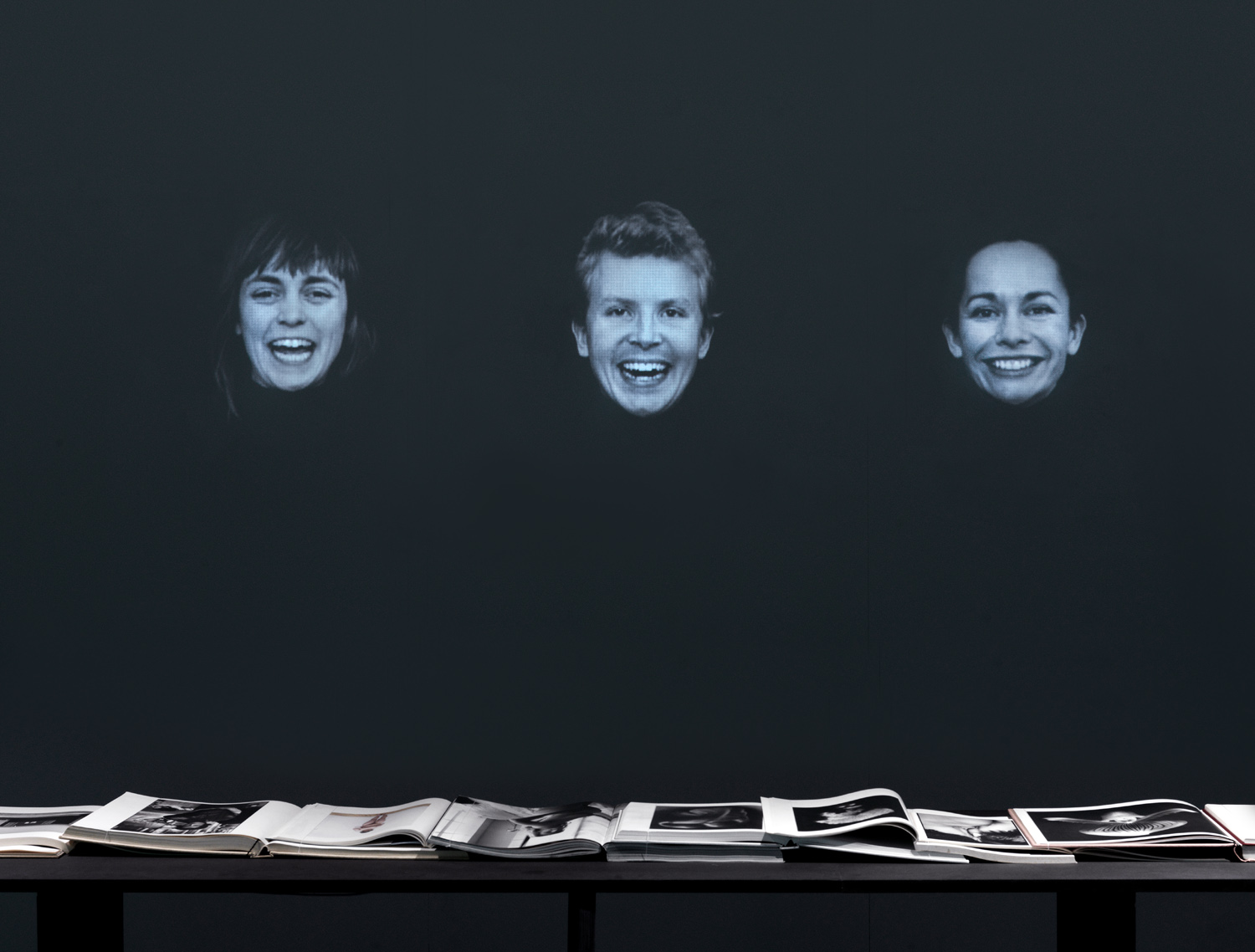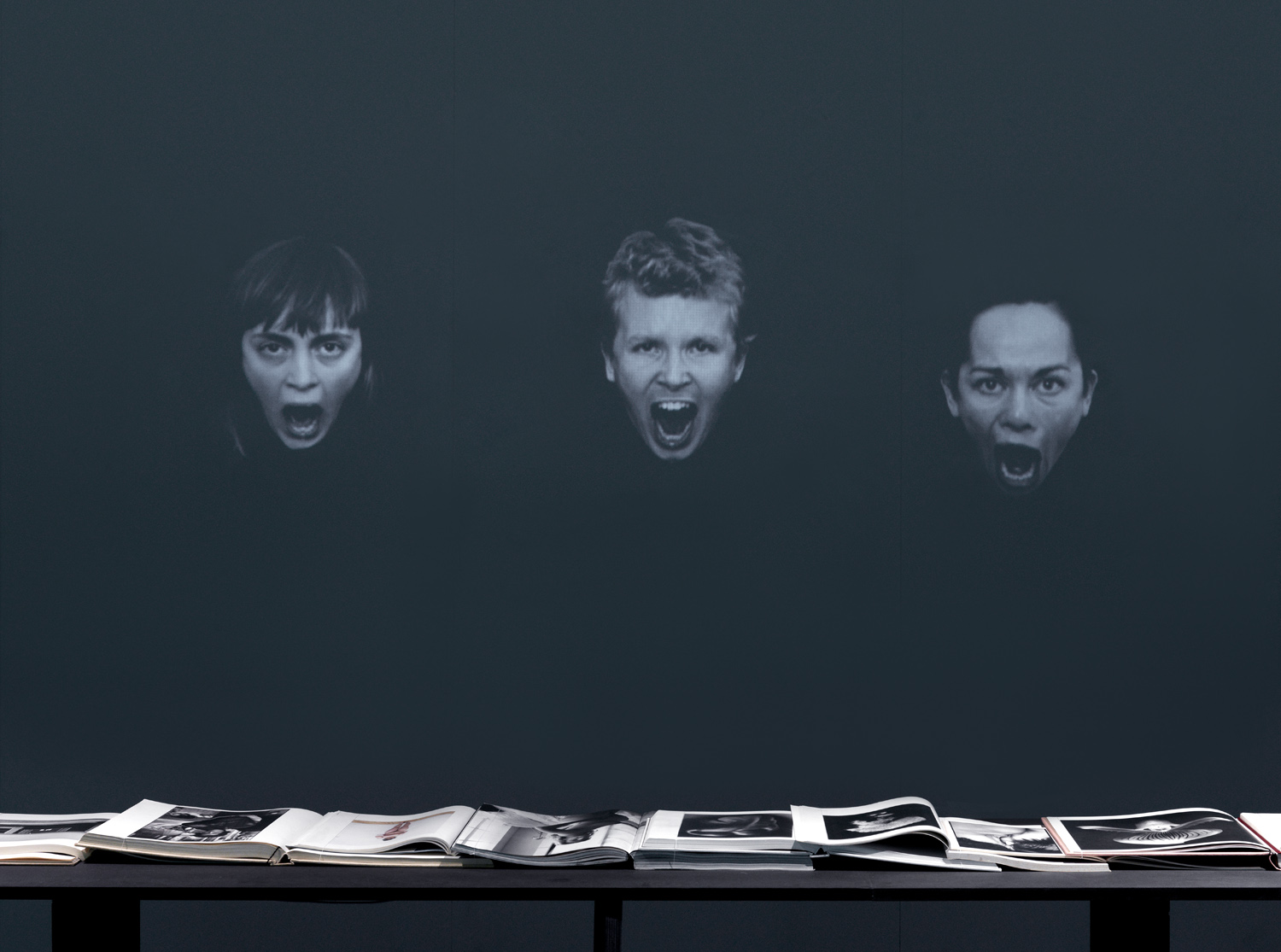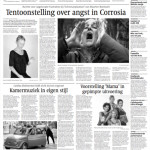Five Faces 2012
Five Faces
4-channel HD videos b/w in loop, no sound, rear projection screens, 600 cm x 900 cm, variable dimensions, also individually shown
In the video installation Five Faces, Roos van Geffen investigates the complex layers of shared human experience.
Five Faces is a video choreography in four parts, projected on four black projection screens, hanging at eye level. The spectator can move freely between the screens and see the projection on both sides of the screen. Five, three, two and one faces can be seen in succession.
At the first screen, five people of various ages: three women, two men, look directly at the viewer and nod yes. The yes movements start quietly, evolve to extremes and then start again. New associations and meanings constantly emerge within these known movements. Associations arise with politicians who can only nod yes or a flock of birds, but also with animals that surrender.
On the second screen you see three younger people; very slowly, the corners of their mouths turn up, creating a subtle smile. Then, a guffaw. The roar of laughter slowly transforms from a beastly expression to a silent, terrifying scream. The faces then relax and recover – or so it seems. For in that moment, the scene repeats itself.
On the third screen two older people shake their heads, faster and faster, the head a machine, associations with strict parents, but also with madness and confusion.
Finally on the last screen a young woman, she breathes in and she breathes out. At first she looks calm, her breathing becomes deeper and deeper. Interlocking associations with meditation, exercise, making love, climaxing, giving birth, drowning and dying. Then she recovers and the sequence starts again.
Roos van Geffen works in different layers of the tradition of conceptual art and the post-medial paradigm of aesthetics, striving to connect concept and sensual experience – The Word and The Feeling. Referring to the phenomenological theory of perception, the artist problematises human consciousness and the possibility of sensual introspection, primarily through images of corporeality, the human presence in the world as a way to represent, to co-present, and to think. Within the framework of her aesthetic research, the artist addresses the question – what does it mean to be human? What does it mean to live and die, to feel and to be present in this world and in our body? She researches different ways of revealing humanity itself.
The installation Five Faces was first shown at Corrosia Almere in 2012 at the exhibition Who’s afraid of…? a group show with works of Anouk Kruithof, Els Vanden Meersch, Nicky Maas, Maarten Boekweit en Roos van Geffen.
Yes 3:48″ on 400cm x 80cm screen
Smile 4:54″ on 240cm x 80cm screen
No 3:52″ on 160cm x 80cm screen
Breath 5:09″ on 80cm x 80cm screen
Yes / Five Faces 3:48”
Smile / Five Faces 4:54”
No / Five Faces 3:52”
Breath / Five Faces 5:09”
Performers: Anne van Balen, Thijs Bloothoofd, Fried Mertens, Nathalie Smoor, Johanna van Steen, editing and camera: Magda Augusteijn, visualisations: Lisanne Hakkers, photos Gert Jan van Rooij
Dutch newspaper NRC Handelsblad: ****Our non-verbal behavior unites as much as it divides, Van Geffen seems to say. Not a very sensational insight, but that is less important in this physical performance. Experiencing is more important than understanding, and the experience here is intense: how the performers emit sound using their entire body, faster and louder, first reaching the orgasmic, then culminating in a series of animal screams. There is a great tendency to distance yourself from it, but at the same time it feels close, recognisable, human.
Gooi- en Eemlander, Margriet van Seumeren: “In the upper room of Corrosia! you can see the video installation ‘Five faces’ with five heads nodding yes. On another screen people laugh and shake no, while on yet another screen a woman breathes hard and then falls silent. You do not hear anything, you only see the images. When you take the time, the video installation makes a deep impression. ”
Moon Saris: “The beautiful work, ‘Five Faces ‘(…) took my breath away and gave air at the same time. Beautiful, but also painful. Delicate, but also terrifying. Paradoxically, exactly what I love because nothing is ever really unambiguous. It appealed to my heart, but also to my head. Every day should contain a portion of this, then you would never allow yourself to take things and people for granted and for granted, and you would reflect daily on the wonder that is called man and life, feeling and thinking.”





